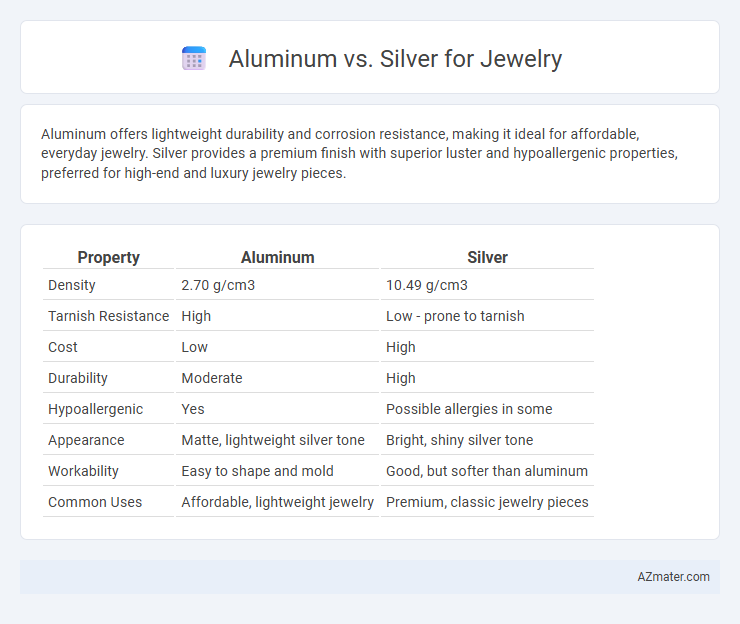Aluminum offers lightweight durability and corrosion resistance, making it ideal for affordable, everyday jewelry. Silver provides a premium finish with superior luster and hypoallergenic properties, preferred for high-end and luxury jewelry pieces.
Table of Comparison
| Property | Aluminum | Silver |
|---|---|---|
| Density | 2.70 g/cm3 | 10.49 g/cm3 |
| Tarnish Resistance | High | Low - prone to tarnish |
| Cost | Low | High |
| Durability | Moderate | High |
| Hypoallergenic | Yes | Possible allergies in some |
| Appearance | Matte, lightweight silver tone | Bright, shiny silver tone |
| Workability | Easy to shape and mold | Good, but softer than aluminum |
| Common Uses | Affordable, lightweight jewelry | Premium, classic jewelry pieces |
Aluminum vs Silver: Material Overview
Aluminum offers lightweight, corrosion-resistant properties, making it ideal for everyday jewelry that requires durability and comfort. Silver, known for its lustrous shine and malleability, is traditionally valued in jewelry for its classic appearance but requires regular maintenance due to tarnishing. Both metals present unique advantages depending on the desired balance of cost, weight, and care.
Appearance and Aesthetics
Aluminum jewelry offers a lightweight, modern aesthetic with a sleek, matte or brushed finish that appeals to minimalist and contemporary styles. Silver, known for its bright, reflective shine and classic elegance, provides a timeless beauty that enhances formal and traditional jewelry designs. While aluminum's natural gray tone contrasts with silver's lustrous white-metal appearance, both metals can be polished or anodized to expand their visual appeal.
Durability and Strength Comparison
Aluminum jewelry offers lightweight durability but is significantly softer, rating around 2.5-3 on the Mohs hardness scale, making it prone to scratches and dents compared to silver. Silver, typically sterling with 92.5% purity, scores about 2.5 on Mohs but is denser and tougher due to alloying metals, providing enhanced strength and longer-lasting wear. While aluminum resists corrosion better, silver's moderate strength and tarnish resistance with proper care make it more suitable for everyday jewelry durability.
Weight and Comfort When Worn
Aluminum jewelry is significantly lighter than silver, making it more comfortable for extended wear, especially for larger or statement pieces. Silver, with its higher density, feels heavier on the skin, which some wearers may find burdensome during prolonged use. The lightweight nature of aluminum reduces strain on the ears, fingers, and wrists, enhancing overall wearability without compromising style.
Hypoallergenic Properties
Aluminum jewelry is often preferred for its hypoallergenic properties, making it ideal for sensitive skin and allergy sufferers. Silver, particularly sterling silver, contains copper and other alloys which can sometimes cause skin irritation or allergic reactions. Choosing aluminum minimizes the risk of contact dermatitis, ensuring a comfortable wear for those prone to metal allergies.
Tarnish and Maintenance Needs
Aluminum jewelry offers superior resistance to tarnish compared to silver, making it a low-maintenance option ideal for everyday wear. Silver, while prized for its luster, requires regular polishing and anti-tarnish care to prevent oxidation and dullness. Choosing aluminum reduces the need for frequent cleaning, while silver demands consistent upkeep to maintain its shine.
Cost and Affordability
Aluminum jewelry offers a significantly lower cost compared to silver, making it an affordable choice for budget-conscious buyers. Silver's higher price is driven by its precious metal status and durability, which also enhances its long-term value. When considering cost and affordability, aluminum provides a lightweight, inexpensive alternative while silver maintains greater resale potential and perceived luxury.
Popular Jewelry Types for Each Metal
Aluminum is popular for lightweight, casual jewelry such as bracelets, earrings, and fashion rings due to its affordability and corrosion resistance. Silver is favored for high-end, classic pieces including engagement rings, fine necklaces, and intricate earrings because of its lustrous finish and malleability. Both metals cater to different style preferences, with aluminum appealing to trendy, everyday wear and silver to timeless, elegant designs.
Sustainability and Eco-Friendliness
Aluminum ranks higher in sustainability due to its abundance and recyclability, reducing environmental impact compared to silver mining. Silver extraction often involves toxic chemicals like cyanide, posing significant ecological risks and energy consumption. Choosing aluminum jewelry supports eco-friendly practices by minimizing resource depletion and promoting circular economy principles.
Choosing the Right Metal for Your Jewelry
Choosing the right metal for your jewelry involves considering both durability and appearance, where aluminum offers lightweight properties and resistance to tarnish, making it ideal for everyday wear. Silver provides a classic, lustrous finish with higher value but requires regular polishing to maintain its shine and prevent oxidation. Factors such as budget, skin sensitivity, and design preference play crucial roles in selecting aluminum or silver for your jewelry collection.

Infographic: Aluminum vs Silver for Jewelry
 azmater.com
azmater.com